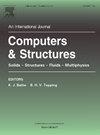Damage localization using a deep learning-based response modeling method
IF 4.4
2区 工程技术
Q1 COMPUTER SCIENCE, INTERDISCIPLINARY APPLICATIONS
引用次数: 0
Abstract
Existing multi-damage localization methods usually need to be trained using labeled data obtained from various damage cases, and such methods can identify multiple damages with high accuracy. However, it’s extremely challenging to obtain labeled data from engineered structures under various damage states, especially in multiple damages case. Thus, damage localization methods that need to be trained using only structural health data have received much attention as an alternative. In addition, existing multi-damage localization methods are mainly based on structural dynamic responses, such as acceleration, whereas structural quasi-static responses are also sensitive to damage location and perform well in damage localization, such as strain response. However, existing quasi-static response-based damage localization methods usually focus on the single-damage localization problem, ignoring the double- and multi-damage localization problems. Therefore, this paper develops a multi-damage localization method based on strain response modeling using the DL-AR-ATT model. The proposed method was compared with one of the latest methods, the BiLSTNet-A-based method, and validated using both simulation and experimental datasets. The results illustrate that the proposed method can accurately locate single and double damage and outperformed the BiLSTNet-A-based method, especially in high noise levels and minor damage cases.
基于深度学习的损伤定位响应建模方法
现有的多损伤定位方法通常需要使用从各种损伤案例中获得的标记数据进行训练,这种方法能够以较高的准确率识别多损伤。然而,从工程结构中获取各种损伤状态下的标记数据是极具挑战性的,特别是在多重损伤情况下。因此,只需要使用结构健康数据进行训练的损伤定位方法作为一种替代方法受到了广泛关注。此外,现有的多损伤定位方法主要基于结构的动态响应(如加速度),而结构准静态响应对损伤定位也很敏感,在应变响应等损伤定位方面表现良好。然而,现有的基于准静态响应的损伤定位方法通常只关注单损伤定位问题,而忽略了双损伤和多损伤定位问题。因此,本文采用DL-AR-ATT模型建立了基于应变响应建模的多损伤定位方法。将该方法与最新的基于bilstnet的方法进行了比较,并通过仿真和实验数据集进行了验证。结果表明,该方法能够准确定位单损伤和双损伤,在高噪声和小损伤情况下的定位效果优于基于bilstnet的方法。
本文章由计算机程序翻译,如有差异,请以英文原文为准。
求助全文
约1分钟内获得全文
求助全文
来源期刊

Computers & Structures
工程技术-工程:土木
CiteScore
8.80
自引率
6.40%
发文量
122
审稿时长
33 days
期刊介绍:
Computers & Structures publishes advances in the development and use of computational methods for the solution of problems in engineering and the sciences. The range of appropriate contributions is wide, and includes papers on establishing appropriate mathematical models and their numerical solution in all areas of mechanics. The journal also includes articles that present a substantial review of a field in the topics of the journal.
 求助内容:
求助内容: 应助结果提醒方式:
应助结果提醒方式:


